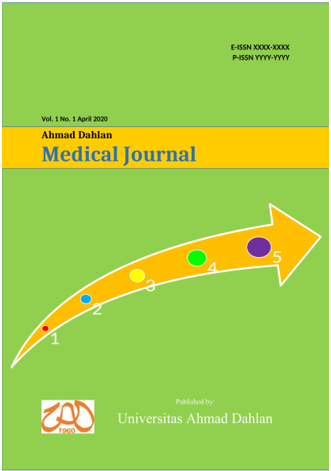Hubungan Pengetahuan Pencegahan Covid-19 Dengan Latar Belakang Pendidikan Pada Masyarakat Kelurahan Langenharjo
Prevention Knowledge of COVID-19 and Connection with the Education Background of People in Langenharjo Village
Keywords:
Covid-19, Knowledge, Transmission, PreventionAbstract
Dissemination of COVID-19 being considerable especially in Indonesia with large population. Prevention from this disease need cooperation between government, medic, paramedic, and public concern. Education is the most prominent to understand the spread of this disease. Other factors that influenced the knowledge are media of information, socioeconomic, culture and environment. This study wanted to know the relationship between education background and the knowledge of COVID-19 prevention. The population of this study were 98 respondents with 48 women and 50 men. This study used spearman rank method to analyzed the relationship between education background and knowledge of COVID-19. The result from this study was 5 respondents with poor and fair knowledge and 88 respondents with good knowledge. The relationship between education background and knowledge of COVID-19 prevention was significant. Other factors also had important role in COVID-19 prevention knowledge. In this study, the education background influenced the COVID-19 prevention knowledge of Langenharjo people significantly.References
Singhal T. A Review of Coronavirus Disease-2019 (COVID-19). Indian J Pediatr. 2020;87(4):281-286. doi:10.1007/s12098-020-03263-6
Wu YC, Chen CS, Chan YJ. The outbreak of COVID-19: An overview. J Chinese Med Assoc. 2020;83(3):217-220. doi:10.1097/JCMA.0000000000000270
Perlman S. Another decade, another coronavirus. N Engl J Med. 2020;382(8):760-762. doi:10.1056/NEJMe1917479
WHO. Modes of transmission of virus causing COVID-19: implications for IPC precaution recommendations. https://www.who.int/news-room/commentaries/detail/modes-of-transmission-of-virus-causing-covid-19-implications-for-ipc-precaution-recommendations. Published 2020.
Wang L, Wang Y, Ye D, Liu Q. A review of the 2019 Novel Coronavirus (COVID-19) based on current evidence. Int J Antimicrob Agents. 2020:105948. doi:10.1016/j.ijantimicag.2020.105948
Rothe C, Schunk M, Sothmann P, et al. Transmission of 2019-NCOV infection from an asymptomatic contact in Germany. N Engl J Med. 2020;382(10):970-971. doi:10.1056/NEJMc2001468
Morawska L, Cao J. Airborne transmission of SARS-CoV-2: The world should face the reality. Environ Int. 2020;139(April):105730. doi:10.1016/j.envint.2020.105730
Taylor D, Lindsay AC, Halcox JP. c or r e sp ondence Aerosol and Surface Stability of SARS-CoV-2 as Compared with SARS-CoV-1. 2010:0-2.
Ong SWX, Tan YK, Chia PY, et al. Air, Surface Environmental, and Personal Protective Equipment Contamination by Severe Acute Respiratory Syndrome Coronavirus 2 (SARS-CoV-2) from a Symptomatic Patient. JAMA - J Am Med Assoc. 2020:2-4. doi:10.1001/jama.2020.3227
Gu J, Han B, Wang J. COVID-19: Gastrointestinal Manifestations and Potential Fecal–Oral Transmission. Gastroenterology. 2020;(April):118-119. doi:10.1053/j.gastro.2020.02.054
Xia J, Tong J, Liu M, Shen Y, Guo D. Evaluation of coronavirus in tears and conjunctival secretions of patients with SARS-CoV-2 infection. J Med Virol. 2020;(February):589-594. doi:10.1002/jmv.25725
Chen H. Susceptibility of ferrets, cats, dogs, and different domestic animals to SARS-coronavirus-2. bioRxiv. 2020:2020.03.30.015347. doi:10.1101/2020.03.30.015347
Kemenkes. Buku Saku Protokol Tata Laksana Covid-19. Buku Saku Protokol Tata Laksana Covid-19 edisi-2. 2020;2:56–60.
Lotfi M, Hamblin MR, Rezaei N. COVID-19: Transmission, prevention, and potential therapeutic opportunities. International Journal of Clinical Chemistry. 2020;508:254–66.
Notoatmodjo, S. 2014. Ilmu Perilaku Kesehatan. Jakarta: Rineka Cipta.
Sari, D. P., Sholihah, N., Atiqoh. 2020. Hubungan antara pengetahuan masyarakat dengan kepatuhan penggunaan masker sebagai upaya pencegahan penyakit Covid-19 di Ngronggah. Jurnal ilmiah rekam medis dan informatika kesehatan, 10(1).
Silva JG da, Carla Sofia Silva, Bárbara Alexandre, Pedro Morgado. Education as a Predictor Factor for Knowledge of COVID-19 in Portugal. Public Health Education and Promotion. 2021;9(15):5–6.
Nurhanah, Ridwan A, Abdullah T. Faktor-Faktor Yang Berhubungan Dengan Kejadian Tuberkulosis Paru Pada Masyarakat Di Propinsi Sulawesi Selatan 2007. Jurnal MKMI. 2010;6:204–9.
Sampurno MBT, Kusumandyoko TC, Islam MA. Budaya Media Sosial, Edukasi Masyarakat dan Pandemi COVID-19. Jurnal Sosial Budaya. 2020;7(6):536–8.
Downloads
Published
How to Cite
Issue
Section
License
Copyright (c) 2023 Rizka Ariani, Muhammad Faruq Assyauqy, Nuni Ihsana

This work is licensed under a Creative Commons Attribution-ShareAlike 4.0 International License.
License and Copyright Agreement
In submitting the manuscript to the journal, the authors certify that:
- They are authorized by their co-authors to enter into these arrangements.
- The work described has not been formally published before, except in the form of an abstract or as part of a published lecture, review, thesis, or overlay journal. Please also carefully read Ahmad Dahlan Medical Journal posting Your Article Policy.
- That it is not under consideration for publication elsewhere.
- That its publication has been approved by all the author(s) and by the responsible authorities - tacitly or explicitly - of the institutes where the work has been carried out.
- They secure the right to reproduce any material that has already been published or copyrighted elsewhere.
- They agree to the following license and copyright agreement.
Copyright
Authors who publish with Ahmad Dahlan Medical Journal agree to the following terms:
- Authors retain copyright and grant the journal right of first publication with the work simultaneously licensed under a Creative Commons Attribution License (CC BY-SA 4.0) that allows others to share the work with an acknowledgment of the work's authorship and initial publication in this journal.
- Authors are able to enter into separate, additional contractual arrangements for the non-exclusive distribution of the journal's published version of the work (e.g., post it to an institutional repository or publish it in a book), with an acknowledgment of its initial publication in this journal.
- Authors are permitted and encouraged to post their work online (e.g., in institutional repositories or on their website) prior to and during the submission process, as it can lead to productive exchanges, as well as earlier and greater citation of published work.


